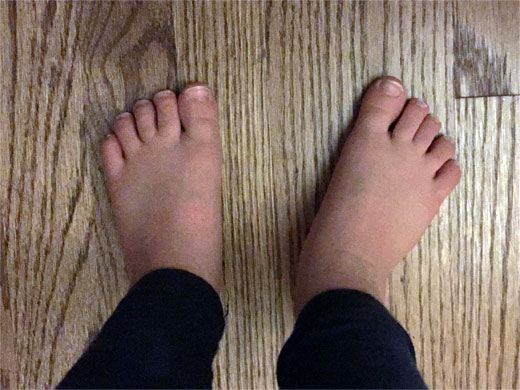Retiring A Well-Traveled Journal

It’s been said over and over that all good things must come to an end. Where some ends are because something is broken or changed, it can be simply because something has come to its natural conclusion. That latter case is what I am doing with a writing journal, as I have recorded thoughts on its last blank page.
In the past I have talked about how I write out most all of my blog posts. Call me old-fashioned, but it works for me. Of course sometimes I just put fingers to the keyboard (all 2 of them) For those I have written (read: printed) most were captured in a journal.
This particular journal is a college-ruled composition notebook I bought at Target on September 5, 2012, and I only remember that as it was a Target-brand notebook, and the day I bought it I wrote my first post in it, Remember Team Morale During Work Stress. Since then it has captured many blog posts, brainstorming for blog topics, scratch paper for other uses – such as my kids stats from their last doctor’s appointment – as well as a doodle pad for said kids. Where many things were written from front to back, others started from the back to front, and the last post I wrote in there, My Takeaways From The Book 52 Motivational Quotations For Salespeople By Tom Cruz, was about two-thirds of the way through it. That being said, it was a very organized collection.
What To Do?
So what do I do with a journal that has traveled just about as much as I have over the last several years? Do I simply recycle it, shred it, or save it? I am not about to start saving notebooks, especially as I am trying, with moderate success, to declutter my life. But as I simply can’t discard it altogether, I cut the spine from it and fed it into my Fujitsu ScanSnap scanner, saved it as a PDF document, and have archived it with my other personal documents. That way, if 100 years from now someone wants to know how The Hot Iron was created, they can look at a PDF file rather than yellowing pages in a dusty box. That is if that dusty box wasn’t long tossed out by my future grandchildren first.
This post you are now reading was written out in another journal I bought at a Walgreens last summer and wrote my first post on the book Scrum, as that day I did not have my other journal with me and I needed something to capture my writing, It too has had some other uses, some I hope to share in the future.
What do you use to capture your creativity? Please share in the comments of this post… and let me know if you typed it straight from your mind or after transcribing it from paper.
This is from The Hot Iron, a journal on business and technology by Mike Maddaloni.
Did you enjoy this? Subscribe to The Hot Iron by RSS/XML feed or Read by Email.
Blogging • Build • (0) Comments • Permalink
First 2 Steps To Take To Start Blogging

As follow-up to my inquisitive and popular blog post on 2 questions I ask anyone thinking about blogging, namely to those who are still interested in blogging after reading it, I now would like to offer advice on how to get started with your blog.
First, setup a free blog at Wordpress.com
You need a blog in order to blog. A blog is a Web site with a content management system (or CMS) which is software on a Web server that allows you to easily publish what you write.
If you have been to a blog site before, there is a good chance it’s on Wordpress, as it is the most well-known and used blog CMS. Wordpress can be used for entire Web sites as well, and not just blogs, but we won’t get ahead of ourselves too much here. Another reason for using Wordpress.com is in its portability potential. If you build a blog at Wordpress.com and in the future you decide you want to move it to another Web host, you can literally export the site and move it. Note I have oversimplified how I described this process and some technical expertise is involved.
Plus, creating a blog at Wordpress.com is free, so if you start one and realize it’s too much for you, there is no major financial commitment.
Register and set a domain name for your blog
Where I just got done telling you to create a free blog, now I am recommending you spend a little more on a domain name.
By registering a domain name for your blog and tying it to your Wordpress.com blog, you gain in several ways. By default, your blog will be named something like myblogname.wordpress.com, but myblogname.com is a more unique name and easier to remember. Also, if you decide to move your blog in the future, you can keep the same Web address – you will not be able to keep myblogname.wordpress.com as that is not your own domain name, wordpress.com.
A domain name also a unique name to your blog. Where it may be presumptive that your blog will be a runaway smash hit on the Internet. If you have peered around The Hot Iron there are plenty of articles on getting your own domain name and other benefits of doing so. You can register a domain name many places, and I always recommend name.com and note I did not get paid to say that!
Ready to blog in no time
Setting up a blog on Wordpress.com and registering a domain name can all be done in under an hour. Configuring your blog and performing some customizations may take a little longer, and that all depends on how much you want to do, though I wouldn’t focus too much on the look of your blog and rather on its substance – the writing!
I hope this has helped, and please share a comment to this post once you do it and share the link to your new blog for all to see.
This is from The Hot Iron, a journal on business and technology by Mike Maddaloni.
Did you enjoy this? Subscribe to The Hot Iron by RSS/XML feed or Read by Email.
Blogging • Build • Technology • Web Design • (0) Comments • Permalink
Web Content Horror Stories For Halloween

Come gather children and adults, huddle by the flickering fire, sip on hot apple cider, all while I, in the shadowy light of the fire, tell stories this Halloween season – true stories, horror stories of Web site content!
The Scream
Many, many years ago I worked for a tech consulting firm that was undergoing rebranding. This exciting process was to include a new look to the Web site. As we were in the business of building Web sites, we were going to build out the ability to maintain the site as well. Note this was years before the term content management system, or CMS, was ever in vogue.
The project was assigned to myself and another senior guy I will call Rocky. There was a little bit of competitiveness between us, partly due to our own cockiness and confidence in our abilities, not to mention he was a Packers fan and I was a Patriots fan, but I digress. In some regards I think that's why both of us were put on the project. We would be building the technology, integrating the new branding and graphic design from the marketing firm and designing sample content, as the president of the company would be writing all of the content, as this is what he told us.
Despite our attitudes, Rocky and I worked very well together. We built out the front-end, back-end, database and sample “lorem ipsum” content. And we did it all on time.
Here's where the story gets scary... the president asked to meet with us at a predefined time in the project plan to review our progress. To his surprise – which quickly and surprising to us we saw on his face – we showed him a, for the most part, complete Web site. All it would need is a few small adjustments... and a lot of content.
Though we were in a brightly-lit office, the room got suddenly dark and eerie. The typically congenial voice of the president got heavy and creepy. Then, timed with a hypothetical clap of thunder, the screaming began.
As time and attempts to forget about this have clouded specifics, in general our frightening leader said, “how dare you finish on time when I didn't even start to write the content!” What? We were numb to the proverbial “second one” he was ripping into us, and it seemed like hours afterwards we were still stunned. Then, after he left, we laughed, hysterically, for what also seemed like hours.
The Original Blank Page
It was a work day like any other, multitasking away in and on my Web consulting business. A friendly chime sounded as my often co-collaborator and an amazing graphic designer n her own right – we'll cal her Sierra – called as we were partnering on a Web site proposal. It was mostly written, reviewing back and forth by email, and we were meeting to make a final walkthrough together before submitting it to the prospective client.
As we went through the proposal line-by-line, word-by-word, it was almost as if a light springy piano tune was playing in the background by none other than Liberace himself. As we got through the end of the document, where we listed references and example Web sites, we both paused as we were reviewing the list. Even though we were on the phone, over 1,500 miles apart, it was as if we were in the same room, pointing to the same spot in the document.
Just as Sierra began to say what I was thinking, it was as if Liberace was vaporized to dust and the Phantom of the Opera took over at the bench and with the flick of some switch, the piano became a pipe organ, and the Phantom played the most sinister music known. Then Sierra spoke, "THIS Web site... when was the last time you looked at it?” The silence over the phone was broken by more organ music, which was timed with each of us typing the Web site's URL into our Web browsers.
As we navigated beyond the home page the music got louder and more daunting, as we looked at empty page after empty page, with nothing on them at all – not one word of content! The shrieking in our voices was beyond our control. This Web site had been live for almost a year with several completely blank pages, to which we could not believe. My gut reaction took over, as I logged into the CMS for the site and placed some basic “coming soon” messages. There was no way we could use this great looking Web site with blank sub-pages as an example of the great work we did. Where the placeholder text was not the ideal situation, it was really all we could do, and in the end turned out to be sufficient as we won the proposal.
Only a Few of Many Stories
Over the years I have encountered Web content horror stories, almost from the time I started creating Web sites. I share these stories not to criticize people or to make fun of them, rather to serve as a cautionary tale of the importance of content development for Web sites. It is not something to do casually – or not at all – and is vital to the success of your site.
Boo!
This is from The Hot Iron, a journal on business and technology by Mike Maddaloni.
Did you enjoy this? Subscribe to The Hot Iron by RSS/XML feed or Read by Email.
Blogging • Build • Business • Strategize • Web Design • (0) Comments • Permalink
Put Your Smartphone Lock Screen To Work To Save Your Device

Whenever someone gets a new or upgraded mobile device, the first thing they do is customize it. From app icon placement to wallpaper images, they do all that they can to make it suit their needs... or ego, or both.
I’d like to share a mobile customization that you can easily do, and it can help you get your device back in case it is ever lost or stolen – customize the lock (or security) screen with your contact information.
It Works!
This idea is actually nothing new for me, as it dates back before I had an iPhone, and even back before I had a Nokia – going back to almost 6 years when I had a Palm 680 smartphone. In those golden years, the lock screen of the Palm allowed you to customize a text message, of which I did with with my name, phone and email address. All was good until one night when I was running late to do the lights and sounds for a friend’s improv show, and in the process of running from the train to the theater, I dropped my Palm device. This I didn’t realize until right before the show started, as I reached to silence a device that was not there. As I had my contact info right there when the kid who found it turned it on, he was able to email me, and we met the next day to get my phone back. Phew!
Create Your Own Image
With today’s popular phones, you can do this with customizing the background image – or wallpaper – on the phone’s lock screen, as you can see that I did on the above photo of my iPhone. In this case, I used PhotoShop, the graphic design software, to create an image to fit on the lock screen, and added the text I wanted. If you don’t have graphic design software, you can still do this a variety of ways, including these tips for the iPhone, Android or Windows Phone. If this is beyond your tech savviness threshold, you can just print out a piece of paper with your info on it, take a picture of it, and save it as the lock screen wallpaper.
But Wait, What About Find My Phone Apps?
Yes Virginia, there are apps and core functionality of devices that allow you to track your device using GPS. And yes, these apps can work to help you retrieve your device. But if someone finds your phone, and when turning it on sees you name, this can be a deterrent to them to whatever nefarious things they may have considered doing to it. Plus they may even get in touch with you prior to you yourself realizing it is missing or can get to a computer to use that find function.
Will You?
Sometimes the simplest solution is the most effective. Your lock screen doesn’t have to be as simple as mine – it can have style, and your contact information as well. If this has convinced you to create a custom lock screen, please let me know in the comments to this post. As well, if you would never consider doing this, I’d like to know that too.
This is from The Hot Iron, a journal on business and technology by Mike Maddaloni.
Did you enjoy this? Subscribe to The Hot Iron by RSS/XML feed or Read by Email.
Build • Mobile Technology • Strategize • Technology • Web Design • (0) Comments • Permalink
My Takeaways From The Book Scrum by Jeff Sutherland
Imagine a workplace where not only you can work without impediments to your progress, but one where you have a say in what and how you do it? And to top of it you’re much more productive and successful and so is your ultimate business customer.
So what’s the catch? You simply have to drop the current way you work and adopt something called Scrum.
What is Scrum? The origins of the word come from the sport rugby, where a tight formation of players move and work together to get the ball forward. The term Scrum here has its origins on software development, where a small team of people work closely together to build software. The difference is in how they build it – using an iterative cycle of a few usable features at a time rather than defining everything upfront, then months (or years) later receiving software with all of the features.
The later process I described above is commonly referred to as “waterfall.” As one giant cycle produces all software (or the falling water) and the remaining project time is used to fix bugs and make changes in the business process (or the water flowing from the waterfall). It is far from a perfect system, especially as it doesn’t take into consideration business changes, let alone end users not always knowing what they want, both upfront or a year from now!
The former process I described above is Scrum, and was created in the 1990’s by Jeff Sutherland and Ken Schwaber. This book, Scrum: The Art of Doing Twice the Work in Half the Time, is written by Sutherland, and presented in a format to introduce Scrum to the wider world outside of software.
As someone who has built software all of my professional career and then some and has used scrum formally in some of my past roles, I was interested to read this book, not only because it is written by one of the co-founders of Scrum, but to learn more how it can be used in other aspects of business and life.
Among my many thoughts from reading Scrum, I have the following takeaways:
- Building software – or anything really – is a journey – It’s hard to be perfect and know upfront everything you will possibly need in software you will use. Rather, admit it is a journey, build it over time, and get it closer to your needs while getting functioning features along the way.
- You have to be committed to Scrum to reap its true potential – Dipping your toes in the Scrum swimming pool will not give you the benefits of it. You have to fully commit to it. If you are hesitant to commit, read the book.
- If you don’t do it someone else will – Scrum as a framework is always gaining in popularity, and the number of people becoming certified in Scrum as well. If you or your organization is resistant to it, realize more organizations are always adopting it.
- I want to be Scrum Certified more now than before – after reading the book and hearing Sutherland’s stories of Scrum’s successes in business and beyond, I really want to take formal Scrum training and become certified more than I did before reading the book.
Scrum: The Art of Doing Twice the Work in Half the Time is a great read, for those who work in business or any organization. I wish I had this book years ago when I was starting my Web consulting business – not just for building the Web software but for the overall running of my business. It is packed with stories of its successful use in various industries. Though it is very supportive of Scrum, it is not a “fluffy” and rah-rah story – it gets straight to the point and reinforces all that is stated. The book concludes with a step-by-step plan for deploying Scrum.
This is the part of my book takeaways where I disclose why I read a book. As I said, when I heard of it, I needed to get it and bought it myself, and for 2 reasons. The first and most important is that I wanted to read the story. The second and anecdotal reason is that I once worked at the same company as Jeff Sutherland, and we once had a brief work-related phone call. As I read Scrum, I could hear his no-nonsense style, which added to the reading.
As I conclude this post, I have not decided whom to give the book to, as it is something I do after I read one. If you are interested let me know. If you have read the book, or based on this are interested to, I welcome your thoughts in the comments to this post.
This is from The Hot Iron, a journal on business and technology by Mike Maddaloni.
Did you enjoy this? Subscribe to The Hot Iron by RSS/XML feed or Read by Email
Book Take-Aways • Build • Business • Agile / Scrum • Strategize • Technology • Thrive • (2) Comments • Permalink




